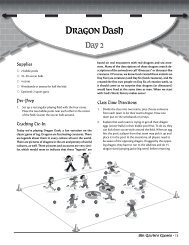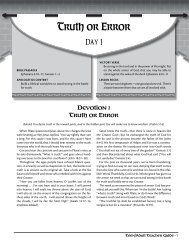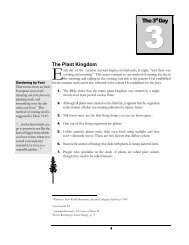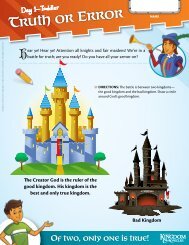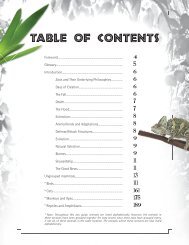BIBLE CURRICULUM - Answers in Genesis
BIBLE CURRICULUM - Answers in Genesis
BIBLE CURRICULUM - Answers in Genesis
- No tags were found...
You also want an ePaper? Increase the reach of your titles
YUMPU automatically turns print PDFs into web optimized ePapers that Google loves.
Lesson 1Recommended ResourcesNotesThe <strong>Answers</strong> Book for Kids, volume 1 (book for children)Explor<strong>in</strong>g Planet Earth (textbook for children)Explor<strong>in</strong>g the World Around You (textbook for children)Explor<strong>in</strong>g the World of Chemistry (textbook for children)Science and the Bible, volumes 1–3Six Short Days! (DVD for children)Available from www.<strong>Answers</strong>Bookstore.com or by call<strong>in</strong>g 1-800-778-3390.1. If you are familiar with the “vapor canopy” model, please note that many creation scientistshave abandoned the vapor canopy model or no longer see any need for such a concept. Formore <strong>in</strong>formation, read “Noah’s Flood: Where Did the Water Come From?” at the onl<strong>in</strong>eTeacher’s Resource Page.2. The creation of plants on Day 3—before the sun and animals—is contrary to the beliefs ofevolutionists and other “long-agers” who teach that plants arose long after the sun came<strong>in</strong>to existence.Are plants “alive”? The Bible makes a clear dist<strong>in</strong>ction between the status of plants andanimals. Plants are not alive <strong>in</strong> the biblical sense. People and animals are described <strong>in</strong> <strong>Genesis</strong>as hav<strong>in</strong>g, or be<strong>in</strong>g, nephesh (Hebrew)—see <strong>Genesis</strong> 1:20–21, 24, where nephesh chayyah istranslated “liv<strong>in</strong>g creatures,” and <strong>Genesis</strong> 2:7, where Adam became a “liv<strong>in</strong>g soul” (nepheshchayyah). Nephesh conveys the basic idea of a “breath<strong>in</strong>g creature.” It is also used widely<strong>in</strong> the Old Testament, <strong>in</strong> comb<strong>in</strong>ation with other words, to convey emotions, feel<strong>in</strong>gs, etc.Perhaps nephesh refers to life with a certa<strong>in</strong> level of consciousness. Plants do not have suchnephesh, so Adam eat<strong>in</strong>g a carrot did not <strong>in</strong>volve “death” <strong>in</strong> the biblical sense.3. Some people ask, “If the universe is only a few thousand years old, then how can we seelight from stars that are over one billion light-years away?” There are several possibleanswers to this question, and creation scientists are actively research<strong>in</strong>g this topic. See “DoesDistant Starlight Prove the Universe Is Old?” at the onl<strong>in</strong>e Teacher’s Resource Page for more<strong>in</strong>formation.20 - Creation part 1





